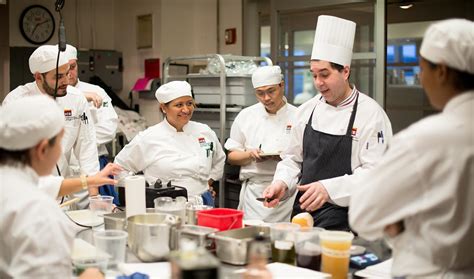Are you passionate about food and cooking? Have you ever considered pursuing a career in the culinary arts? In recent years, culinary arts programs in American universities have gained popularity as aspiring chefs and food enthusiasts seek formal education and training in the culinary field. In this blog post, we will delve into the world of culinary arts programs in American universities, exploring the various benefits of pursuing such programs, how to choose the right program, and which schools are considered the top in the country. We will also take a closer look at the curriculum, hands-on training opportunities, industry connections, internships, and career pathways for graduates. Additionally, we’ll be sharing success stories of notable alumni who have made a mark in the culinary world after completing their studies in American universities. Whether you’re considering a career change or are a high school student exploring your options, this post will provide valuable insights into the world of culinary arts education in the United States.
Table of Contents
Exploring Culinary Arts Programs in American Universities
When it comes to pursuing a career in the culinary arts, American universities offer a diverse range of programs to cater to aspiring chefs and culinary professionals. From the bustling kitchens of New York City to the charming culinary schools in the heart of the Midwest, there are countless options for students looking to explore the world of culinary arts in the United States.
One of the key factors to consider when exploring culinary arts programs in American universities is the variety of specializations and focuses that each program offers. Whether you are interested in classic French cuisine, sustainable cooking and food systems, or even the art of pastry and dessert making, there are programs tailored to suit every culinary interest.
Furthermore, the hands-on training and experiential learning opportunities available in American culinary arts programs are unmatched. From state-of-the-art kitchen facilities to opportunities to work in top-rated restaurants and hotels, students have the chance to hone their skills in a real-world setting, preparing them for success in the competitive culinary industry.
Lastly, exploring culinary arts programs in American universities also means delving into the rich network of industry connections and potential career pathways available to graduates. With internships, externships, and networking opportunities, students have a chance to gain valuable insights and connections that can pave the way for a successful career in the culinary arts.
Benefits of Pursuing Culinary Arts in American Universities
When it comes to pursuing a career in the culinary arts, there are numerous benefits to attending an American university. One of the main advantages is the access to world-renowned faculty and industry professionals who can provide mentorship and guidance. American universities also offer state-of-the-art facilities and cutting-edge equipment, providing students with the best possible learning environment.
In addition, studying culinary arts in America allows students to experience a diverse range of cuisines and culinary traditions. This exposure to different cultures and food practices can greatly enrich the learning experience and provide students with a well-rounded education in the culinary arts.
Furthermore, pursuing culinary arts in American universities opens up a wealth of networking opportunities. Many prestigious culinary schools have strong connections with industry leaders, which can lead to valuable internships, externships, and job offers upon graduation.
Lastly, attending an American university for culinary arts can provide students with a strong foundation for a successful career in the industry. The rigorous curriculum and hands-on training offered by these programs can prepare students for the demands of the culinary world and set them up for long-term success.
Choosing the Right Culinary Arts Program in the US
When it comes to pursuing a career in the culinary arts, choosing the right program is crucial for your success. With so many options available in the US, it can be overwhelming to decide which one is the best fit for you. It’s important to consider factors such as curriculum, facilities, faculty, and industry connections when making this decision.
One of the first things to consider when choosing a culinary arts program in the US is the curriculum. Look for a program that offers a well-rounded education in both traditional and modern cooking techniques, as well as courses in nutrition, food safety, and menu planning. A strong curriculum will provide you with the knowledge and skills you need to succeed in the culinary industry.
Another important factor to consider is the facilities and resources available to students. A top-notch culinary arts program will have state-of-the-art facilities including fully equipped kitchens, a variety of cooking tools and equipment, and access to quality ingredients. Hands-on experience is essential in culinary education, so be sure to choose a program that offers plenty of opportunities for practical training.
Finally, it’s important to consider the faculty and industry connections of the culinary arts program. Look for a school with experienced faculty who are dedicated to helping students succeed. Additionally, a program with strong industry connections can provide students with valuable networking opportunities and access to internships and externships in top restaurants and food establishments.
Top Culinary Arts Schools in America: Rankings and Reviews
Have you been considering pursuing a career in the culinary arts? If so, you may be wondering which culinary arts schools are the best in America. With so many options to choose from, it can be overwhelming to navigate through the various programs and determine which one is the right fit for you. To make your decision a little easier, we’ve compiled a list of the top culinary arts schools in America, complete with rankings and reviews to help you make an informed choice.
One of the top culinary arts schools in the United States is the Culinary Institute of America (CIA). With campuses in New York, California, and Texas, the CIA offers a rigorous and comprehensive culinary education that is highly respected in the industry. The school’s world-class faculty and state-of-the-art facilities make it a top choice for aspiring chefs.
Another highly regarded institution is the Institute of Culinary Education (ICE) in New York City. ICE boasts an impressive roster of alumni, many of whom have gone on to achieve great success in the culinary world. The school’s industry connections and hands-on approach to learning make it a standout choice for students looking to jumpstart their careers in the culinary arts.
Additionally, the International Culinary Center (ICC) in New York and California is known for its top-notch curriculum and experienced instructors. With a focus on both classic and modern culinary techniques, the ICC prepares students for success in a variety of culinary settings, from fine dining restaurants to catering companies.
Curriculum Overview: What to Expect in American Culinary Arts Programs
When pursuing a culinary arts program in an American university, students can expect a well-rounded curriculum that covers a wide range of topics related to the culinary industry. From fundamental cooking techniques to advanced pastry arts, students will have the opportunity to gain a comprehensive understanding of various culinary disciplines.
Furthermore, students can expect to learn about food safety and sanitation, menu planning, nutrition, and kitchen management. These courses are designed to provide students with the knowledge and skills necessary to succeed in the culinary industry.
In addition to hands-on cooking classes, students can also expect to take courses in wine studies, food and beverage pairing, and hospitality management. This well-rounded curriculum ensures that students are equipped with the knowledge and expertise needed to excel in the fast-paced and competitive culinary world.
Overall, students can expect to receive a thorough education that prepares them for a successful career in the culinary arts, with a focus on both practical skills and theoretical knowledge.
Hands-On Training: The Key to Success in US Culinary Arts Programs
Hands-on training is an essential component of any successful culinary arts program in the United States. This type of training provides students with valuable practical experience that cannot be gained through traditional classroom instruction alone. By working directly with professional chefs and industry professionals, students are able to develop their skills and knowledge in a real-world setting, preparing them for the demands of a career in the culinary arts.
During hands-on training, students have the opportunity to apply what they have learned in the classroom to actual food preparation and cooking. This allows them to gain a better understanding of the techniques and methods used in professional kitchens, as well as the importance of precision and attention to detail. Additionally, hands-on training often includes opportunities for students to work in various culinary settings, such as restaurants, catering companies, and hotels, allowing them to explore different career pathways within the industry.
Furthermore, hands-on training provides students with the chance to receive feedback and guidance from experienced professionals, helping them to improve their skills and confidence in the kitchen. This personalized mentorship can be invaluable in shaping the future success of aspiring chefs and culinary professionals, as it allows them to learn from the expertise and experience of those already working in the field.
Overall, hands-on training is a key factor in the success of US culinary arts programs, as it equips students with the practical experience and knowledge needed to thrive in a competitive, fast-paced industry. By combining hands-on training with comprehensive classroom education, students are able to develop the well-rounded skill set and expertise necessary to achieve their goals and pursue a fulfilling career in the culinary arts.
Industry Connections: Networking Opportunities for Culinary Students
Networking in the culinary industry can be a game-changer for aspiring chefs and food professionals. Building connections within the industry can open doors to new opportunities, mentorship, and valuable insight into the world of food and hospitality. Culinary students who take advantage of networking opportunities can gain a competitive edge in the job market and develop a strong foundation for a successful career.
One of the main benefits of networking for culinary students is the chance to connect with established professionals in the field. Whether through industry events, job fairs, or alumni networks, students can meet experienced chefs, restaurant owners, food writers, and other industry insiders who can offer guidance and advice. These connections can lead to internships, job offers, or valuable recommendations that can jumpstart a student’s career.
Furthermore, networking allows culinary students to stay current with industry trends and best practices. Engaging with professionals and peers can provide insight into new techniques, emerging food trends, and innovative culinary concepts. By staying connected, students can adapt to the ever-evolving landscape of the culinary industry and position themselves as forward-thinkers and innovators in the field.
Finally, networking provides a platform for culinary students to showcase their skills and creativity. Whether through industry competitions, collaborative projects, or social media, networking allows students to share their work and build a personal brand. This exposure can lead to recognition, opportunities for collaboration, and a strong professional reputation within the culinary community.
Internships and Externships: Gaining Real-World Experience in American Universities
Internships and externships are invaluable opportunities for students pursuing culinary arts in American universities. These real-world experiences provide students with the chance to apply the skills and knowledge they have gained in the classroom in a professional setting. By participating in internships and externships, students can gain hands-on experience, build their professional network, and enhance their resumes, making them more competitive in the job market upon graduation.
One of the main benefits of participating in internships and externships is the opportunity to work alongside experienced professionals. This allows students to observe best practices, learn new techniques, and gain insight into the inner workings of the industry. Additionally, students have the chance to receive feedback and guidance from supervisors, helping them to develop and refine their skills.
Another advantage of internships and externships is the chance to make valuable connections in the industry. Through these experiences, students can build relationships with chefs, restaurant owners, and other industry professionals. These connections can lead to job opportunities, mentorship, and ongoing support throughout their careers.
Overall, internships and externships are essential components of a culinary arts education in American universities. These experiences allow students to gain real-world experience, develop valuable connections, and enhance their professional skills, setting them up for success in the competitive culinary industry.
Career Pathways: Job Prospects for Graduates of American Culinary Arts Programs
Graduates of American culinary arts programs have a wide range of job prospects in the food and hospitality industry. With the skills and knowledge acquired from their training, culinary graduates can pursue various career paths that align with their interests and goals.
One of the most common job prospects for graduates is working as a chef in a restaurant, hotel, or catering company. As a chef, graduates can showcase their culinary expertise and creativity in creating diverse and delectable dishes that satisfy the palates of diners.
Another career pathway for culinary graduates is becoming a food and beverage manager. In this role, graduates can oversee the operations of food and beverage establishments, manage budgets, and ensure top-notch customer service.
Additionally, culinary graduates can explore opportunities in food styling, food writing, culinary education, and entrepreneurship. Whether graduates choose to work in the kitchen, front-of-house, or beyond, their culinary arts education equips them with the foundation to excel in various job roles.
Success Stories: Notable Alumni from US Culinary Arts Programs
Success stories of notable alumni from US culinary arts programs serve as an inspiration for students pursuing a career in this field. These individuals have not only achieved success in their culinary careers but have also made significant contributions to the industry. Their stories showcase the diverse opportunities available to graduates of American culinary arts programs and highlight the potential for growth and success in this field.
One such notable alumni is Chef Thomas Keller, who is a graduate of the Culinary Institute of America. Keller is known for his globally acclaimed restaurant, The French Laundry, and has been awarded multiple Michelin stars. His success has made him a prominent figure in the culinary world, and his journey serves as a source of motivation for aspiring chefs.
Another success story is that of Chef Gordon Ramsay, who attended Johnson & Wales University before becoming a renowned chef and television personality. Ramsay’s numerous Michelin-starred restaurants and successful television shows have established him as a household name in the culinary industry, showcasing the potential for graduates of American culinary arts programs to reach great heights in their careers.
These success stories not only highlight the achievements of notable alumni but also emphasize the diverse career pathways available to graduates of US culinary arts programs. Whether it’s owning a prestigious restaurant, becoming a celebrity chef, or making an impact through unique culinary innovations, these alumni demonstrate the limitless potential for success in the culinary arts.






